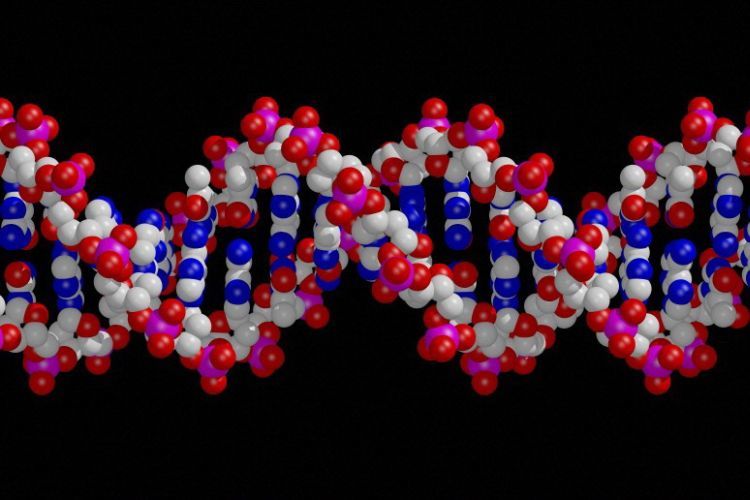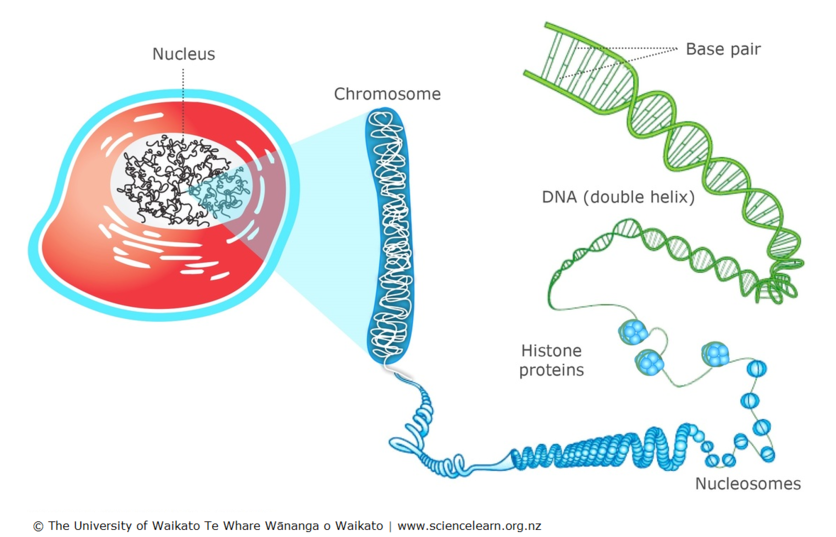We hear about DNA all the time, whether it’s in a news story or the latest crime show on TV. But what exactly is DNA? Where is it found? Why is it important? To answer these questions, we need to take a closer look inside our cells.
DNA is stored in chromosomes
Our bodies are made up of trillions of cells. Each cell contains a number of different organelles that all play an important role in cell function, such as breaking down waste or producing energy.
The cell nucleus is the most important organelle, and it’s here that we find our DNA (deoxyribonucleic acid) packaged up tightly into structures called chromosomes. Chromosomes are long thread-like structures made of a DNA molecule and protein. During cell division, chromosomes coil up tightly into X shapes and are more easily visible under a microscope. Human cells have 23 pairs of chromosomes.
DNA is organised into genes
Each chromosome is made up of a DNA molecule, but what does a DNA molecule actually look like and how does it store information?
A DNA molecule is made up of a series of nucleotides arranged in 2 strands that resemble a ladder and twist to form a double helix.
Nucleotides are made up of a base, a sugar and a phosphate. The 4 bases – adenine (A), guanine (G), cytosine (C) and thymine (T) – pair with each other (A with T and G with C). It is the order or sequence of these base pairs that provides the information needed for the growth and development of our bodies. It can help to visualise the bases as letters in the alphabet that form words when they are in a certain order. These ‘words’ are called genes and act like a set of instructions for our cells.
Gene expression
Because the human genome has been sequenced, we know that humans have approximately 25,000 genes. Each gene provides the instructions for a unique protein (and sometimes for many versions of that protein). When a gene produces proteins in a cell, we say that the gene is being expressed.
Gene expression has 2 main stages. First, specialised cell structures read the gene and use this information to produce a molecular message in the form of an mRNA (messenger ribonucleic acid) molecule – this process is called transcription. Following this, the mRNA molecule moves from the nucleus into the cytoplasm of the cell. A ribosome reads the message and produces a protein that exactly matches the instructions coded for in the gene – this process is called translation
Every cell in your body (other than gametes) contains the same DNA and consequently the same genes. However, not every gene is expressed in every cell. When a particular gene is expressed, we say that this gene is ‘on’. When a gene is on, it is making proteins that affect the functioning or development of the organism in some way.
Deciding whether a gene is on or off is a highly specific and complex process. It is regulated by cues from within and outside the cells and results in the incredible diversity of cells we see in our bodies. For example, the genes that code for muscle proteins such as actin and myosin are only expressed in muscle cells, not in the other cells in your body, even though the genes are present in those other cells.
Scientists have learned how to control gene expression via a process called RNA interference. This biotechnology tool has applications in human medicine, agriculture, horticulture and pest management.
Nature of science
The complex work carried out by the scientists in this context would not be possible without the cell research and DNA discoveries made by past scientists.
Useful links
Visit the Learn Genetics website to go on animated tours covering DNA, genes, chromosomes, proteins, heredity and traits.
Watch this video clip From Mendel to DNA where Nobel Prize winner Sir Paul Nurse explains 3 key understandings of genetics developed during the 20th century.


